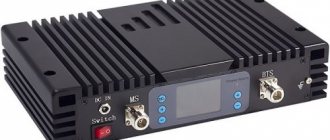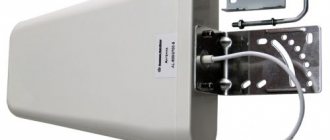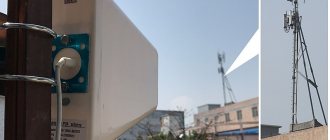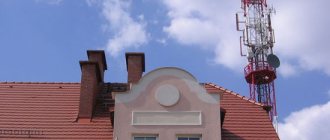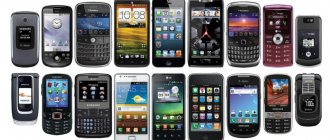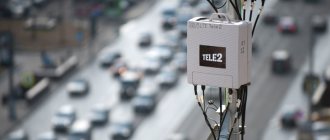In this material we will talk about strengthening the signal of a USB modem, and not with a router. If you are interested in interacting with this type of network equipment, check out a separate thematic article on our website, where you will find all the existing methods that allow you to strengthen the signal when connecting to the network. If you have a router and a 4G modem at the same time, we recommend taking a closer look at Method 5 of this article.
Read more: How to strengthen the signal of a Wi-Fi router
Method 1: Using a different USB connector
You should try the simplest methods first. One of them is to connect the modem to another free USB port on your computer or laptop. This option will be especially relevant for those users who have connected network equipment to the port located on the front panel of the PC. Sometimes a weak signal is due to the fact that the modem simply does not have enough power, so it is preferable to connect it to the motherboard. This method is unlikely to help owners of laptops, but nothing prevents them from checking it.
Make a directional wave Wi-Fi
This method is aimed at narrowing the direction vector of the signal from the router. That is, the modem should distribute Wi-Fi not over 360°, but in a narrow direction. When implementing this technology, the rest of the signal will be reflected and redirected in the required direction, so that you get the maximum effect from the router.
In practice, this method looks somewhat primitive: you need to cover the back of the antenna with a metal screen. The simplest option is to cut an aluminum cola can, bend it into a semi-arch, and install the structure directly behind the antenna.
WIFI signal reflector
To understand: the area behind the screen made of aluminum or tin will be non-working. The signal will be reflected from the foil and redirected in the form of a beam from a concave directional parabola to the PC.
Method 2: Purchase a USB extension cable
Purchasing a USB extension cable to connect a modem is one of the most popular and effective methods of signal amplification. This way you can choose the optimal location of the device in the house so that there are no problems with obstacles in the form of walls. It is recommended to take a longer cable and test the different points available, and then choose the best one from all. If we are talking about a private home, it may be located at a considerable distance from the network tower and much lower than it, which is why problems with signal quality arise. By hanging the modem higher, it is likely that the connection quality will significantly improve.
When implementing this method, remember to check the signal and network speed each time so that you can make your own measurements and determine where the connection was best. It's easier to do this through the USB modem's proprietary software, so just launch it, open the "Status" tab, and then start monitoring the signal quality and current speed.
Minimizing exposure to other devices
Features of signal transmission require the need for its distribution in space. Alas, in open areas the coverage radius will actually be quite large with excellent signal quality. But in a room with reinforced concrete walls, a large amount of furniture and, most importantly, sources of electromagnetic radiation, the propagation of waves encounters a huge number of various obstacles. Of course, not all factors have the same degree of impact.
The most active are:
- microwaves and other high frequency devices;
- industrial frequency electrical appliances powered from a household network;
- amateur radio equipment for broadcasting.
Method 3: Construction of a homemade antenna
Sometimes homemade antennas turn out to be very effective, but this depends on many conditions, which include the chosen type of design and the correctness of its implementation. Some recommend using regular wire, while others talk about remaking the satellite dish. You can familiarize yourself with all the available options for manually creating antennas in other material on our website by clicking on the link below. Keep in mind that such a device is not always effective, so think carefully before you start designing.
Read more: Do-it-yourself antenna for a modem
Method No. 3. Selecting the wireless standard 802.11n
The latest wireless standards include 802.11ac. Despite this, the 802.11n channel has significant advantages over the latter. This technology allows for the use of several antennas at once, allowing signal reception to be enhanced several times. With the transition to the “n” standard, the router can operate at the less noisy 5 GHz frequency, providing maximum coverage area. There is only one “but” here. You can safely switch to the slightly outdated 802.11n standard only if your computer and mobile equipment supports operation at this frequency. This feature is not provided in the latest line of devices.
Method 4: Purchasing a guide antenna
For anyone who does not want to build their own antennas, or for those who are simply not satisfied with this option, we recommend that you resort to ready-made solutions, which are called guide antennas. They can be difficult to find because not all electronics stores carry them. Therefore, you may need to order online or go to a radio market. Look at the parameters and technical characteristics of available devices and choose the best one for yourself. Do not hesitate to consult with the seller to get practical advice.
Signal amplifier for 3g modem made of copper wire
Another way to easily boost the signal of a 3g modem with your own hands will require a little more action than the option with speakers. You need to make a structure from wire and a tin can that will serve as an antenna. The algorithm of actions is as follows:
- Take copper wire (preferably a long piece).
- Open the gadget and make 5-6 turns around the SIM card.
- Pull the other end to the window.
- Take a tin can or cut off the neck of a beer bottle to create a “glass.” It will act as a reflector that enhances communication.
- Wind the free end of the wire to the bottom of the can.
- Turn the neck in the direction where the nearest operator tower is located. The increase in Internet quality will be up to 90-95%.
Method 5: Connecting the modem to the router
As a last method, we will analyze the joint use of a router and a 4G modem to strengthen the signal of the second. Organizing this type of connection will not only expand the coverage area, but will also create a wireless network to which several users can connect at once. However, to do this, you need to make sure that your router has a USB port and supports modem. After that, connect the equipment through this same connector.
The next step is authorization in the router’s web interface. To do this, it must be connected to a computer or laptop using a LAN cable or wirelessly. For information on how to enter settings, read the universal instructions on our website at the link below.
Read more: Logging into router settings
All that remains is to change some parameters to switch the router to the required operating mode. In different device models, this is carried out according to a specific algorithm, so we will consider two radically different options so that each user understands the principle of setup.
D-Link
In D-Link routers and many other models from different manufacturers, 3G or 4G configuration is done quickly using the built-in Wizard, which is perfect for novice users.
- To do this, after logging in to the web interface, expand the “Get Started” section and select “Click'n'connect” or “Quick setup”.
- If a warning appears about the absence of an Ethernet cable connection, just ignore it, because in this mode of operation it is not needed.
- In the provider selection form, leave the value “Manual”.
- The main stage is choosing the connection type. In our case it will be “3G” or “LTE” depending on which protocol the USB modem supports.
- When prompted to enter a PIN code, enter the PIN code to unlock your network equipment, and then complete the setup.
- To check the functionality of the device, go to the “3G modem” section.
- Check its status, signal level and, if necessary, change the PIN code through a separate menu.
ASUS
The second option for implementing the web interface allows you to do without using the Setup Wizard, because working with USB is displayed as an application. ASUS is the most common manufacturer that uses this method in its settings, so we’ll consider it.
- In the Internet center, immediately switch to Russian to understand the menu items.
- Pay attention to the blocks on the left, where through “General” go to the “USB application”.
- Start configuring the modem by switching to the appropriate operating mode.
- Activate this mode by changing the status of the slider responsible for this operation.
- Enter the access point and password if required by the operator. This information can be obtained from the application that you use in the operating system when working with the modem.
- Once complete, apply the changes so that the router will reboot and begin functioning.
If, after applying the settings and rebooting the router, the Internet is still not available via Wi-Fi, it means that the wireless network has not yet been configured. To set its parameters you only need to perform a few steps.
- In the router’s web interface, go to the “Wireless Mode” or “Wi-Fi” section.
- In it, activate the access point to display auxiliary parameters.
- In this menu, change the name of the wireless network to make it easier to find in the list of available ones.
- After that, switch to the Wireless Security category.
- Set the recommended encryption type and enter the password that will be used when connecting.
We are glad that we were able to help you solve the problem. In addition to this article, there are 12,444 more instructions on the site. Add the Lumpics.ru website to your bookmarks (CTRL+D) and we will definitely be useful to you. Thank the author and share the article on social networks.
Describe what didn't work for you. Our specialists will try to answer as quickly as possible.
How to boost a 3g modem signal using speakers
The first option on how to strengthen the signal of a 3g modem with your own hands, which you can try at home without extra expenses and effort, is to use ordinary sound speakers. Mobile Internet users noted that if they move them closer to the modem, the signal level increases by 10-20%. This is not very much, but with poor connection quality it gives a noticeable increase. To get rid of annoying clicks from the speakers, you should turn the sound to minimum.
What affects the Wi-Fi signal and coverage area
Neighborhood Wi-Fi networks. The first and most critical factor affecting the quality of a router’s wireless network is not a microwave, as many people think - no. This is most influenced by the same routers that neighbors have. And if this is not yet evident in the currently new 5 GHz range, then in the usual 2.4 GHz range a critical situation has now developed. The more neighbors you have with Wi-Fi, the worse the signal from your router covers your apartment. Due to interference from neighboring devices, your wireless access point will lose almost half of its power even at a distance of three meters. That is, previously one router worked without problems throughout the entire area of the apartment, but now only on half.
Obstacles in the signal path. This is not only the walls and ceilings of the room, but also furniture, household appliances, interior and metal doors and everything else that is located between the Wi-Fi router and the client device: phone, tablet or laptop. In my practice, there was a case when the access point was in a shielded room and as soon as the door was closed, the network disappeared. I’ll say right away that what the Wi-Fi signal dislikes most is fittings and expanded clay, sheet metal, steel frames and shelving, water supply pipes, large wall-mounted aquariums and mirrors.
Appliances. Here, in addition to the same long-suffering microwave, you can add a bunch of other equipment - large LCD TVs and plasma panels, cordless phones, Bluetooth speakers, baby monitors. Even a long USB 3.0 cable lying along the wall can also negatively affect the quality of the wireless network.
System selection criteria
When choosing a Tele2 cellular signal amplifier, it is important to choose a kit that will satisfy the necessary needs in a specific situation. The main criteria for choosing an amplifier is the area of its application. It is required to establish communication from a source within one room or to ensure reliable reception in a facility with insufficient coverage of cellular operator base stations.
To do this, you can order the services of an operator, whose employees will use special instruments to measure signal frequencies, find a place for reliable reception and select the required option. Installing and configuring the equipment will take a minimum of time.
